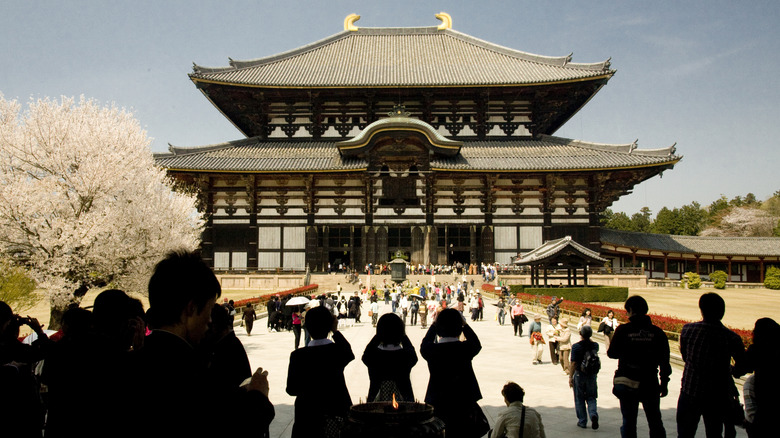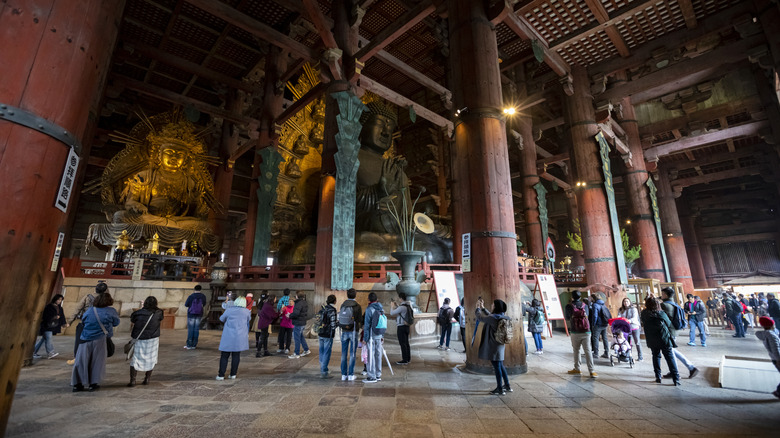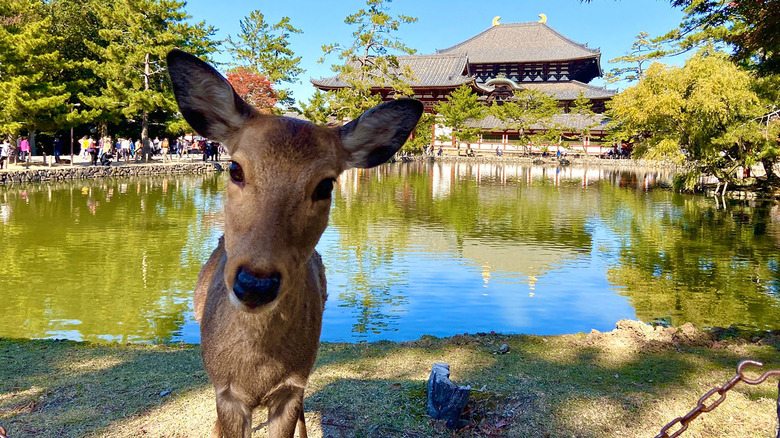One Of Japan's Most Famous Spots Is An Imposing Temple In Nara With Indescribable Beauty
Japan is on the bucket list for many world travelers. However, choosing what to do and when to go can be difficult, especially if you're on a budget. Exploring the Kansai region is one way to get the most bang for your buck — or, rather, yen. This is where the foodie city of Osaka, affectionately known as "Japan's kitchen," is located. It's also home to Japan's most iconic cultural city, Kyoto, with its numerous temples, bamboo forests, and traditional tea houses.
However, there is another standout destination in Kansai that visitors should consider. Nara, the ancient capital, is culture-rich and full of temples but less frequently visited than Kyoto.
One of Nara's most famous spots is the imposing Todaiji Temple, a national treasure that houses an enormous Daibutsu, a nearly 50-foot-tall Great Buddha statue. This UNESCO World Heritage site is part of a sprawling temple complex that encompasses part of Nara Park, which is also home to some of its most famous residents: hundreds of tame and friendly deer who love to greet visitors.
The Great Buddha of Todaiji
Todaiji was officially opened in A.D. 752, when Nara was Japan's capital city, as a commission by Emperor Shōmu to unify Buddhism in the country. It took three years to cast the giant bronze statue of Buddha. The enormous hall that houses it held the record for the largest wooden structure in the world for centuries. Todaiji was an incredible feat of construction for its time and still impresses today — its sheer size can also be slightly intimidating.
Start by entering the main Nandai-mon Gate and pass under the terrifying gaze of the Kongo Rikishi, two giant temple guardians, to enter the complex. For many visitors, this is the highlight of any Todaiji visit. The Great Buddha is truly massive and awe-inspiring. To get a sense of how big the statue truly is, find the pillar at the back of the hall with a large hole at its base. This hole is said to be precisely the size of the Great Buddha's nostril! Anyone who can fit through the hole is said to be blessed with good luck and health for life.
From here, take your time to wander the temple complex. While most visitors clamor to see the Great Buddha Hall, fewer tourists venture to see the smaller halls and peaceful gardens of Todaiji, all of which are equally worthy of exploration. Note that Todaiji Temple is less strict than other shrines and temples in Japan. Visitors can photograph the Great Buddha Hall, for example. However, it's still an active place of worship, so be prepared to take off your shoes if needed. Dress conservatively and act respectfully.
When to visit and how to get there
The best time to visit Todaiji is in the spring or fall. This is when the trees are at their most beautiful, heavy with pink sakura blossoms or tinted red with scarlet maple leaves. It's also a very popular time to visit, so be ready to wait in queues, especially on peak cherry blossom viewing days.
Getting to Todaiji is convenient with either a bus ride or a pleasant half-hour walk from the Nara train station. If you're not sure which direction to go, follow the deer. Plenty are roaming the sidewalks and streets, but most congregate around Nara Park. They are incredibly tame and friendly creatures but can also be quite insistent, demanding the special deer-food biscuits sold in Nara Park. As for human food, there are plenty of restaurants and cafes close to the train station. Maguro Koya is a small restaurant tucked on a side street that serves the highest quality fatty tuna in the simplest of menus.
Nara is an easy day trip from Kyoto or Osaka, with frequently running trains. If you are looking for more interesting sights to explore in the Kansai area, try Kodai-ji Temple, which is surrounded by hidden bamboo groves of serenity and silence. It's also worth considering spending more than one day in Nara. Travel blogger and confessed Japanophile, Nele van Hout, says she makes a point to stay the night when visiting. "Experiencing Nara almost empty early in the morning was magical," she wrote recently on her blog The Navigatio. "It reminded me of what it was like when I visited Nara for the first time years ago."


